What Happens to Human Bodies When They Are Burned?
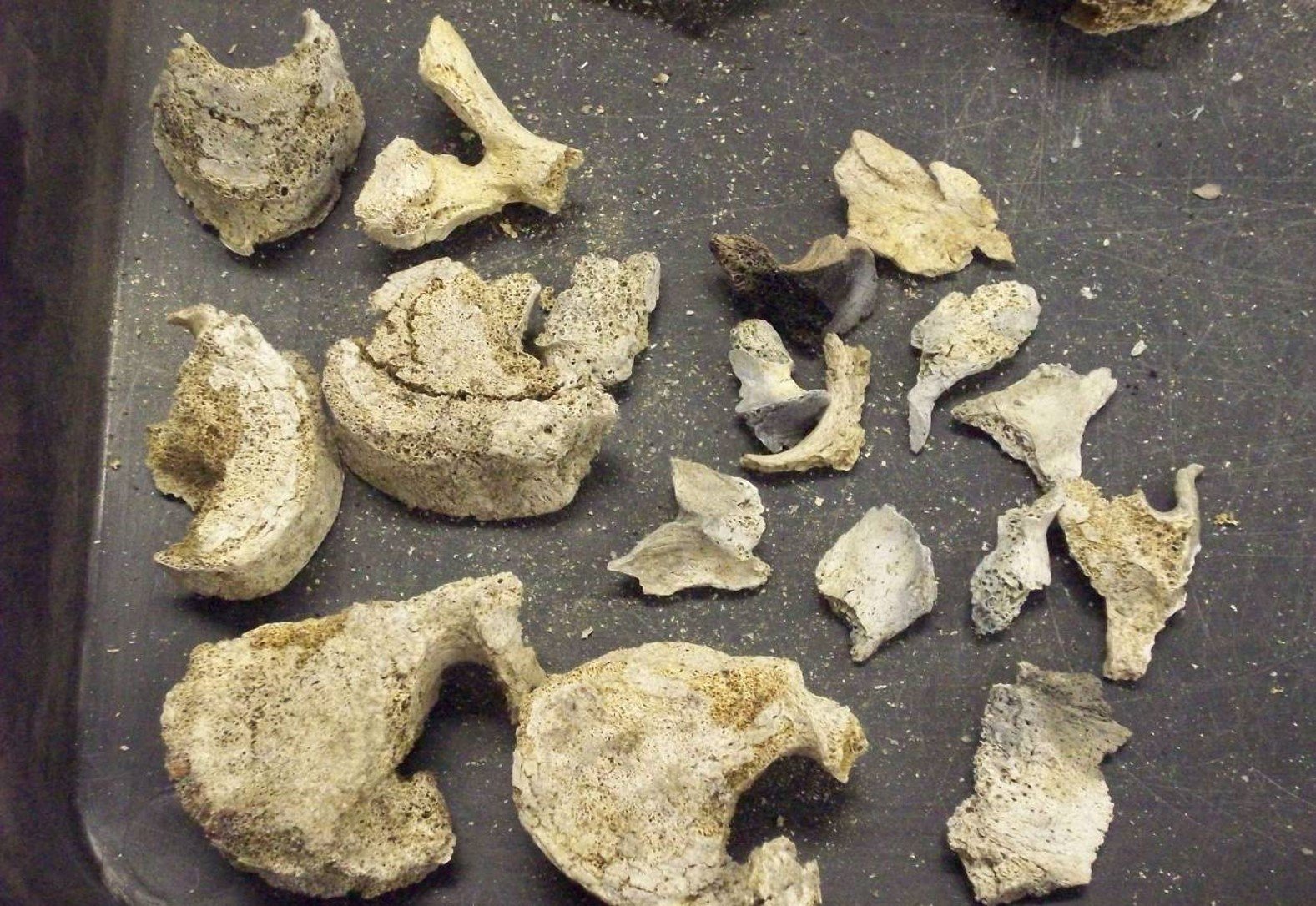
Share this step
Fire is a very destructive force, capable of great damage. Burned human remains can be found in a range of situations, from archaeological funerary urns, to aeroplane crashes, to volcanic eruptions, to modern cremations. Despite this range of contexts, the actual impact on the body and bone (which we term ‘heat-induced changes’) are the same. In fact, in many ways the changes we see due to fire are the same as normal diagenesis over time – just a lot quicker. It is important to note that the skeleton does not ‘turn to ash’ upon burning. Even within modern crematoria, which burn efficiently and at high temperatures, the skeleton will survive. The skeletal remains are then raked from the cremator and the remains placed in a machine known as a cremulator, which grinds the bones into ash. This is because people don’t want to scatter recognisably human fragments of their loved ones.
Bodies during burning
The human body is made up of soft and hard tissues, and fire will have a dramatic effect on both. Fire can be fatal in different ways, but the most common are either due to the heat or suffocation from the smoke produced. The smoke can restrict oxygen flow into the body and contain poisons which can be lethal. The heat of the fire will cause significant damage to the body.
The fire will cause the soft tissues to contract, which causes the skin to tear and the fat and muscles to shrink. The internal organs will also shrink. The muscles contract due to burning and this causes the joints to flex. As a result, burned bodies are often contorted into what’s known as a pugilistic, or boxer pose. This is most clearly seen in the flexed bodies recovered from the ancient city of Pompeii (AD 79) when many died from the extreme heat of the pyroclastic flow from the volcano Vesuvius.
Burned Bones
The heat will also cause significant changes to the bone. The skeleton does not burn in a uniform way. Some bones will burn at a higher intensity than others due to factors such as body fat distribution, proximity to the heat source, etc. For example, the humeri below are from the same individual, but the darker one on the left was burned at a lower intensity to the one on the right, which has become completely calcined.
 Humeri (arm bones) from a single individual. Note the differences in colour (copyright Joy Szigeti)
Humeri (arm bones) from a single individual. Note the differences in colour (copyright Joy Szigeti)
Quite often the peripheral bones of the hands and feet will not be burned to such a high intensity as those at the centre of the body, where most fat is located. Body fat acts as a source of fuel and people with more fat will burn at a higher intensity than very thin people.
Bone goes through four stages of transformation when burned.
1) Dehydration
Removal of water from the bone due to moisture evaporating in response to the heat. This occurs at a temperature range of °C 100-500.
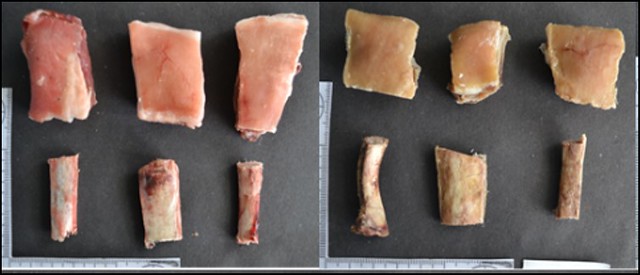 An unburned fragment of animal bone on the left and a partially dehydrated fragment of animal bone which has been burned at a low temperature on the right
An unburned fragment of animal bone on the left and a partially dehydrated fragment of animal bone which has been burned at a low temperature on the right
2) Decomposition
The organic component of the bone (the collagen) is lost.
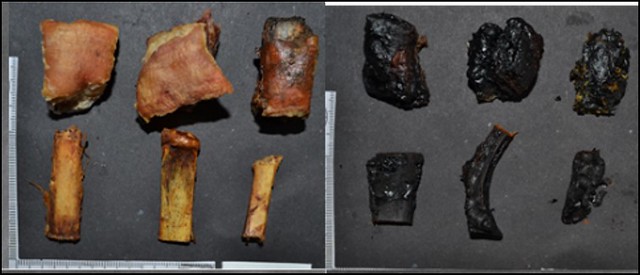 Fragments of animal bone that have been dehydrated due to burning on the left and fragments that have decomposed due to higher intensity burning on the right
Fragments of animal bone that have been dehydrated due to burning on the left and fragments that have decomposed due to higher intensity burning on the right
3) Inversion
Changes to the inorganic, mineral part of the bone, the carbonates. This occurs at a temperature range of °C 500-1100.
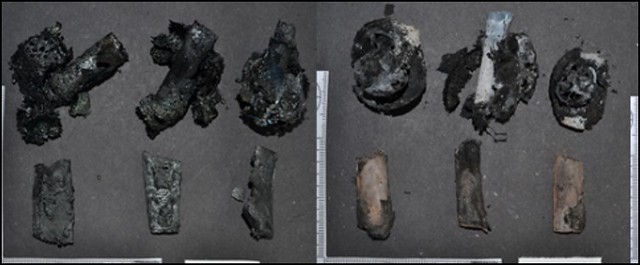 Decomposed fragments on animal bone on the left and fragments showing inversion on the right due to higher intensity burning
Decomposed fragments on animal bone on the left and fragments showing inversion on the right due to higher intensity burning
4) Fusion
The crystals that form the bone mineral start to melt and coalesce together. This occurs at a temperature range of °C 700-1200
 The fragments on the right show evidence of fusions due to higher intensity burning
The fragments on the right show evidence of fusions due to higher intensity burning
These four stages are not discrete phases – a given bone could be experiencing all four stages in different parts at the same time.
What do these changes mean?
These stages result in a number of alterations to the bone structure and appearance. These can make it more difficult for anthropologists who are trying to use these burned remains to produce an osteoprofile.
The Dehydration and Decomposition stages cause an increase in porosity (small holes) in the bone, which leads to increased fracturing, fragmentation and breakage. This is why burned remains are often very fragmented.
The loss of the organic material also causes significant colour change. For many decades, anthropologists and archaeologists have tried to use colour change in burned bone as a way of predicting the temperature reached during burning. They then use this information to make inferences regarding the burning event. As bone burns, its colour moves from a natural creamy-brown state to dark grey to black to light grey and then pure white. The problem with using colour in this way is that it is not only temperature that influences colour change, but also the duration of burning, the oxygen levels, the amount of soft tissue and so on.
The Inversion and Fusion stages result in a reorganisation of the mineral structure of the bone, which leads to shrinkage, reduced porosity, increased crystallinity and a conversion to a more ceramic-like material. In fact, when bone is very well burned it becomes calcined and it can then feel and sound a bit like ceramic. So bone burned at a high intensity can actually preserve much better in the ground than bone burned at a low intensity because of this change to a more ceramic-type crystal structure.
Below are a series of images of bone burned at differing intensities when viewed under a scanning electron microscope. You can see that at low intensity, the bone has holes and fractures in the surface and these get larger under medium intensity burning. These features will mean that the bone is more fragile and may not survive so well in the ground. Then under higher intensity burning, holes become smaller and the cracks disappear. This is the point at which the bone becomes a bit like ceramic and it will then preserve better in the ground.
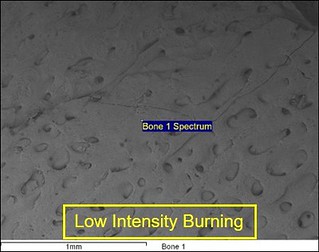
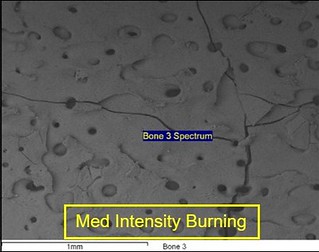
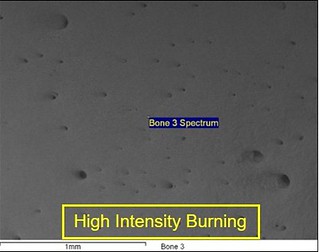
Fractures Characteristic of Burning
When fresh bone is burned (i.e. a fleshed body) characteristic u-shaped fracturing will be visible. These u-shaped fractures can still occur some time after death, but once the soft tissues have decomposed the bone no longer fractures in this way.
 U-shaped fractures on a long bone (Copyright Joy Szigeti)
U-shaped fractures on a long bone (Copyright Joy Szigeti)
If the body is burned after soft tissue decomposition a grid-like fracture pattern is produced (see below).
 *Grid-like fracture patterns on a Neolithic bone from Guernsey (Cataroche and Gowland 2015).
*Grid-like fracture patterns on a Neolithic bone from Guernsey (Cataroche and Gowland 2015).
Sometimes a body is burned after it has fully decomposed. This could be for a number of reasons, such as the building where the body is located catching fire, or because perpetrators are trying to confuse the forensic investigation. In these cases, it is possible to say if significant decomposition had occurred before burning by examining the subtle changes to bone surface and microstructure that the fire causes.
Anthropological Analysis
An approximate age-at-death and sex can still be determined from cremated human remains. Pathological evidence can also be observed in burned remains, including joint disease, or cut marks. This is useful for forensic contexts because perpetrators often think that burning a body will eliminate evidence of trauma (such as knife wounds or dismemberment), but this is not always the case.
DNA can survive in the bone but it is often degraded. Stable isotope evidence for strontium can also be retrieved from the burned remains and experiments are ongoing at Durham University regarding the temperature at which collagen for carbon and nitrogen analysis will still survive. Further examples of recent experiments to advance forensic investigations of burned human remains are presented in the next step.
Share this

Reach your personal and professional goals
Unlock access to hundreds of expert online courses and degrees from top universities and educators to gain accredited qualifications and professional CV-building certificates.
Join over 18 million learners to launch, switch or build upon your career, all at your own pace, across a wide range of topic areas.
Register to receive updates
-
Create an account to receive our newsletter, course recommendations and promotions.
Register for free








